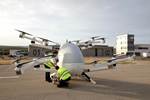Horizon’s Cavorite eVTOL prototype completes initial hover testing
Reports confirm the aircraft is extremely stable, is capable of full hover at only 65% power and has hovered with 20% of its fans purposely disabled.

Cavorite scale prototype. Photo Credit: Horizon Aircraft
According to several sources, Horizon Aircraft Inc. (Toronto, Ont., Canada) has successfully completed initial hover testing of its half-scale Cavorite X5 electric vehicle takeoff and landing (eVTOL) prototype. According to Airframer.com, the company plans to move to transition flight testing in Q1 2023 to the ACE Climatic Wind Tunnel located near Toronto, Ontario.
The 15-foot-long aircraft, confirmed by CW to use composites, features a 22-foot wingspan. It is capable of speeds over 250 kilometers per hour, a 310-mile range and a five-passenger capacity. According to Aerospace Testing International, Cavorite’s design enables it to fly in a low-drag configuration and is safer, more efficient and easier to certify than “radical” new eVTOL designs.
Brandon Robinson, CEO, Horizon, notes that the “aircraft has exceeded expectations during initial hover testing. It is extremely stable, is capable of full hover at only 65% power and has hovered with 20% of its fans purposely disabled in order to test system redundancy ... It continues to yield valuable data that is constantly improving our full-scale design.”
In addition to its work with Cavorite, Horizon is part of a U.S. Air Force competition, AFWERX HSVTOL, to develop a concept for a high-speed VTOL aircraft.
Related Content
-
Plant tour: Albany Engineered Composites, Rochester, N.H., U.S.
Efficient, high-quality, well-controlled composites manufacturing at volume is the mantra for this 3D weaving specialist.
-
Welding is not bonding
Discussion of the issues in our understanding of thermoplastic composite welded structures and certification of the latest materials and welding technologies for future airframes.
-
Next-generation airship design enabled by modern composites
LTA Research’s proof-of-concept Pathfinder 1 modernizes a fully rigid airship design with a largely carbon fiber composite frame. R&D has already begun on higher volume, more automated manufacturing for the future.













